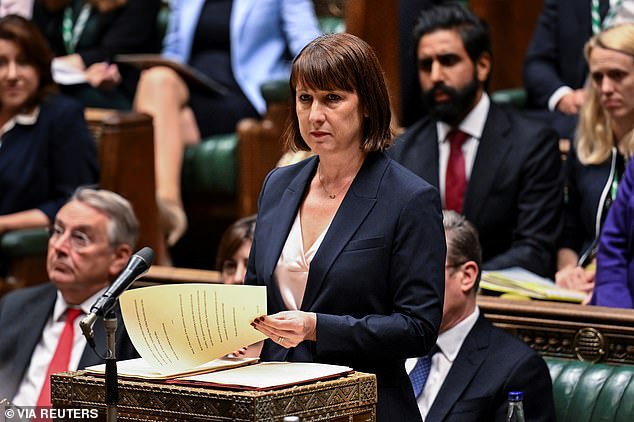It has taken a while for it to be extracted, but the cat is finally out of the bag. Last week, Chancellor of the Exchequer Rachel Reeves laid the groundwork for a gruesome attack on people’s personal wealth – an assault she had defiantly refused to confirm during weeks of fervent electioneering.
Quelle surprise: We warned it would happen as soon as Rishi Sunak called the General Election in late May and the likelihood of a Labour government became blindingly obvious.

Rachel Reeves’s update on the country’s fragile public finances, given to the House of Commons six days ago, was loaded with financial poison
Using the excuse of a £22billion black hole in the country’s public finances, Reeves warned that this financial chasm would have to be filled.
‘There will be difficult decisions around spending, around welfare and around taxes,’ she said, the results of which will form the backbone of the Budget scheduled for October 30.
This hole will not be filled through higher income taxes or hikes in either National Insurance contribution rates or VAT – taxes that Labour pledged not to touch in its election manifesto. Nor through pay restraint in the public sector – Reeves has awarded public sector pay rises worth £9.4billion.
No, the hole will in part be funded by the imposition of means testing for winter payments and horrible taxes on our ability to build personal wealth – retirement money designed to ensure our later years are not undermined by financial insecurity and we are not dependent upon state benefits.
Plain and simple, a vicious attack on thrift is coming our way.
Although the precise details of the assault will not be known until Reeves’ Budget, it is not hard to work out where it will be targeted.
It is likely that the ability to save via company or personal pensions will be compromised. Also, wealth we pass on to loved ones when we die is likely to attract more tax, as will the capital gains we make from the sale of shares, second homes or buy-to-let properties.
Are these justified taxes to correct the Conservatives’ alleged mismanagement of the economy? No. This is Labour showing its true colours. It is payback time.
For all of Reeves’ ‘city cred’ and Sir Keir Starmer’s smarm, new Labour 2024 believes it is time for a dose of good old socialism.
John McDonnell, shadow chancellor under Jeremy Corbyn and now suspended from the Labour Party, must be thinking Christmas has come early. A thought no doubt shared by Angela Rayner. Up the workers! Down with prudence!
So, what is Reeves likely to do to extract more revenue from our financial war chests?
TAX RELIEF ON PENSIONS
If the rumour mill is an indication of what is coming, Reeves could well overhaul the incentives that the state offers to encourage us to put money aside for retirement through a pension. Currently, pension contributions attract tax relief, which means they are tax deductible. The amount of relief is determined by how much income tax someone pays.
For basic rate taxpayers, it is 20 per cent, while higher and additional rate taxpayers (earning respectively more than £50,270 and £125,140) enjoy 40 and 45 per cent relief (the relief regime differs slightly in Scotland).
In simple terms, a £100 contribution into a pension currently costs a basic rate taxpayer £80, while for higher rate and additional rate taxpayers it costs £60 and £55. It’s not a one-way ticket. Although investments within the pension wrapper grow tax-free, the state gets back a chunk of tax when people take their pension – with withdrawals (above the right to tax-free cash) subject to income tax.
The idea that Labour is now mulling over, but has yet to commit to, is to replace these three reliefs with a flat rate – maybe 25 per cent or more likely 30. It would tick all the boxes for Labour. It would give basic rate taxpayers a better pension deal, while hitting up to six million ‘wealthy’ earners with an effective 10 or 15 per cent levy on their pension contributions.
In other words, it would help redistribute pension wealth back in favour of Labour’s so-called ‘workers’ (most of us work damn hard for our money).

HOW YOUR PENSION COULD BE HIT
We asked Andrew King, retirement planning specialist at wealth manager Evelyn Partners, to do some number-crunching, spelling out in pounds and pence the impact of 30 per cent tax relief on our ability to save.
It’s a bit crude, full of assumptions, but it demonstrates how pernicious this tax relief change could be on the size of pension pots that many hard-working people are able to build for their retirement.
First, he has calculated the size of pension fund that people now aged 25 and 35 could build from scratch under the current pension tax relief regime. The people he chose were a basic rate taxpayer earning the average UK salary of £28,000, a higher rate taxpayer on £55,000 and an additional rate taxpayer on a salary of £130,000.
He then did the same calculations, assuming the introduction of a flat 30 per cent rate of relief.
The pots accumulated are at age 65 and based on annual contributions of 8 per cent – 3 per cent from an employer and 5 per cent from the employee – with the tax relief reinvested back into the pension, as it would be in common ‘salary sacrifice’ arrangements. These are standard workplace pension contribution rates.
The numbers confirm that the ability of basic rate taxpayers to build wealth is improved, but is seriously compromised for higher and additional rate taxpayers.
For example, assuming annual investment returns of 4 per cent (net of charges), the 25-year-old basic rate taxpayer would build a bigger pension fund under the 30 per cent flat rate scheme than under the current arrangements – £234,140 versus £212,850.
In contrast, the 25-year-old higher rate taxpayer would see their pension shrink in value by £41,810 – from £418,110 to £376,300.
Additional rate taxpayers would ‘lose’ £174,660. Assuming higher annual investment growth of 6 per cent, the respective gains and losses are bigger – a £34,670 gain for the 25-year-old basic rate taxpayer (from £346,660 to £381,330), and a £68,102 reduction for the higher rate taxpayer (from £680,952 to £612,850). Additional rate taxpayers would ‘lose’ £284,450.
Yet King says these numbers don’t fully represent the punitive impact of a 30 per cent flat rate on taxpayers.
He says: ‘Let’s not forget that millions of today’s basic rate taxpayers are the higher and additional rate taxpayers of the future. This is the case more so than ever as millions of workers are being drawn into higher tax bands because of frozen income tax thresholds.’
These thresholds were frozen until 2028 by then-Tory chancellor Jeremy Hunt – and it is more likely that Reeves will extend rather than unfreeze them.
King adds: ‘Jumps in marginal tax rates on income can act as disincentives to harder work and advancement, so if you then extinguish one significant benefit of climbing those tax steps – the ability to have pension savings boosted by higher rates of tax relief – that could hit motivation and productivity.’
He says our pensions system is ‘envied worldwide for the encouragement it gives to private pension provision’, but warns: ‘With study after study showing people aren’t saving enough for retirement, the flat rate relief idea seems a dangerous move that could throw an almighty spanner into the system, reducing the incentive to save into a pension.’
King’s concern about a flat rate of relief is not universally shared. Romi Savova, chief executive of pensions provider PensionBee, says a flat rate ‘could create a simpler, more uniform approach to pension tax relief, offering a significant advantage to millions of [basic rate] taxpayers by enabling them to accumulate greater pension wealth’.
Tom McPhail, a pensions expert at financial consultant the Lang Cat, does not rule out the introduction of a flat rate of tax relief. But he says it would be ‘hugely complicated’ to introduce.
His view is that other changes may be afoot. These, he says, could take the form of a reduction in the amount of tax-free cash that can be taken from a pension. This is currently up to 25 per cent of the amount built up in a pension, subject to a maximum cap of £268,275.
Alternatively, he says, it may make pensions that are inherited when someone dies subject to inheritance tax – they are currently exempt.
HOW ELSE COULD REEVES PLUG THE £22BN HOLE?
It is not just pensions that are on Reeves’s radar. She could also raise more tax from capital gains on things such as the sale of second homes, buy-to-let properties and shares held outside of an Individual Savings Account.
Currently, any capital gains crystallised above the annual tax-free allowance of £3,000 are taxed at either 10 or 18 per cent for basic rate taxpayers – 10 per cent on share gains and 18 per cent on property. For higher and additional rate taxpayers, the equivalent rates are 20 and 24 per cent.
Reeves could well hike up these rates, so they are in line with income tax rates.
The inheritance tax regime could also become more onerous with an increase in the current 40 per cent charge on estates above the nil-rate allowance of £325,000.
Inherited wealth is despised by Labour, who mistakenly believe it is only the rich who pay tax on it.
Nothing could be further from the truth – it’s a tax increasingly ensnaring Middle Englanders.
KEEP SAVING TO BUILD UP YOUR WEALTH
Although higher wealth taxes are heading our way, nothing is set in stone. We don’t know what higher taxes Reeves will target first and when changes will come in.
It’s unlikely that if big changes are confirmed in October’s Budget, they will be introduced straight away.
The new tax year commencing on April 6, 2025 is a more likely starting date, while some major changes such as an overhaul of pension tax relief could be subject to industry consultation, delaying their introduction even longer.
It is essential therefore that conjecture doesn’t derail your current savings plans. So put as much money into a pension as you can afford to without compromising your day-to-day household finances.
If you are employed, you are likely to benefit from a generous employer’s contribution into your pension – and the more you put in, the more they may be prepared to put in too.
The amount you can put into your pension each year – and receive tax relief on – is £60,000. It’s a generous allowance – use it (it could be slashed in the future).
Savers should also complement pension saving by shielding cash and investments inside a tax-friendly Individual Savings Account. Isas appear not to be on Reeves’s wealth-grabbing radar, so use your annual £20,000 allowance (£9,000 for children).
In terms of inheritance tax, parents and grandparents should utilise various gift allowances that allow them to pass on wealth tax-free. (These are explained at: https://www.gov.uk/inheritance-tax/gifts).
Higher and additional rate taxpayers looking to shield gains on shares should consider using this year’s annual capital gains tax allowance – ahead of a more draconian tax regime coming in next April.
Some links in this article may be affiliate links. If you click on them we may earn a small commission. That helps us fund This Is Money, and keep it free to use. We do not write articles to promote products. We do not allow any commercial relationship to affect our editorial independence.
Source link







